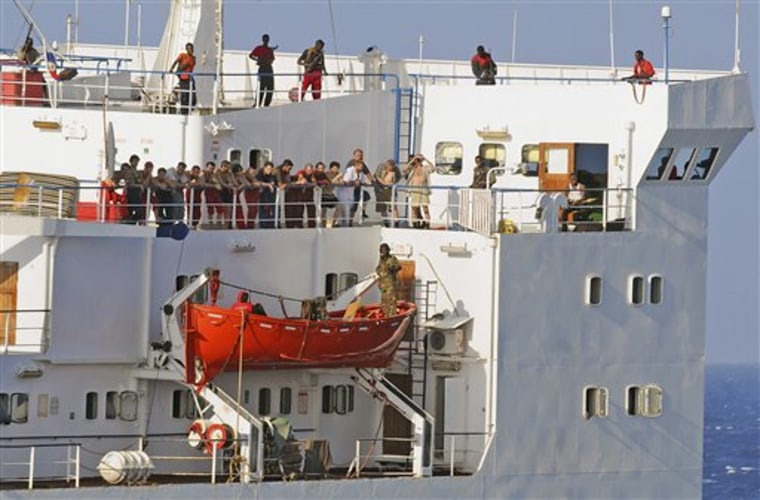A multinational force of warships has carved out a narrow shipping corridor off the coast of Somalia that is helping protect merchant vessels from pirate attacks, the force's commander said Monday.
Ninety percent of ships transiting the perilous Gulf of Aden are using the guarded corridor and there have been no hijackings inside the zone since it was set up on Aug. 22, said Danish Commodore Per Bigum Christensen.
In a telephone interview from his East African base in Djibouti, Christensen said coalition naval forces were also having success using planes, helicopters and drones to find and track suspect vessels until they can be boarded and searched.
Pirate attacks off the Somali coast have surged 75 percent this year, as bandits lured by million-dollar ransoms have pushed farther out to sea in search of bigger prey among the 20,000 oil tankers, freighters and merchant vessels transiting the Gulf of Aden each year.
Pirates continue to hold 11 vessels
There have been 81 attacks this year, and 32 ships have been hijacked, according to the International Maritime Bureau. Eleven vessels remain in the hands of pirates along with more than 200 crew — most notably the Ukrainian freighter, the MV Faina, loaded with tanks and weapons, seized Sept. 25.
The multinational force created the shipping channel to better focus its patrols in the vast area. The zone is about 600 miles long and just three to six miles wide. It runs roughly north-south, allowing ships to safely bypass the Somali coast on their way to and from the Red Sea and the Suez Canal.
Most commercial ships enter the zone on their own, but others group together in convoys with a warship escort.
A few larger and faster ships less vulnerable to attack still move outside the zone, as do "some crazy yachters," Christensen said. Luxury yachts have been among the pirates' targets this year.
Aboard stolen fishing trawlers and other "mother ships" loaded with food, diesel and water, pirates can loiter several hundred miles offshore for days. Hiding among clusters of fishing boats, the bandits launch armed skiffs with powerful outboard engines as attack craft when a target is spotted, often clambering aboard a ship by ladder or grappling equipment in a matter of minutes.
Bandits shifting their tactics
The bandits have already shifted their tactics in response to the patrols, positioning attack teams on the northern and southern ends of the shipping zone to stretch the already thin naval forces, Christensen said.
The naval forces have captured six pirate attack teams — around 60 people — since October, Christensen said. But after seizing their weapons and equipment, the sailors must release the bandits at sea to sail back to Somalia because no country has been willing to bring them to trial.
Somalia has no reliable central government to put them on trial or imprison them.
The naval task force that Christensen commands was initially set up under the U.S.-led war in Afghanistan to patrol the Persian Gulf, the Red Sea and parts of the Indian Ocean. But earlier this year it was diverted to concentrate almost solely on fighting piracy. Known as Combined Task Force-150, it has anywhere from three to 15 ships on patrol at a time.
Besides Denmark, the nations that have been part of the task force are the United States, Germany, France, the Netherlands, Britain, Pakistan and Canada.
NATO ships patrolling area
Separately, ships from the U.S. Navy's 5th Fleet have been deployed to surround the Faina until a resolution to the standoff over the freighter is reached.
A NATO flotilla of seven vessels is also patrolling the area. European Union foreign ministers gave their final approval Monday to send four to six ships to replace the NATO force in December.
The use of military power, Christensen acknowledged, is limited in what it can do to stop a problem driven by lawlessness and poverty in Somalia, a nation at war with itself for most of the past 17 years.
"We can be there and suppress the piracy," Christensen said, "but the problem is on shore."
